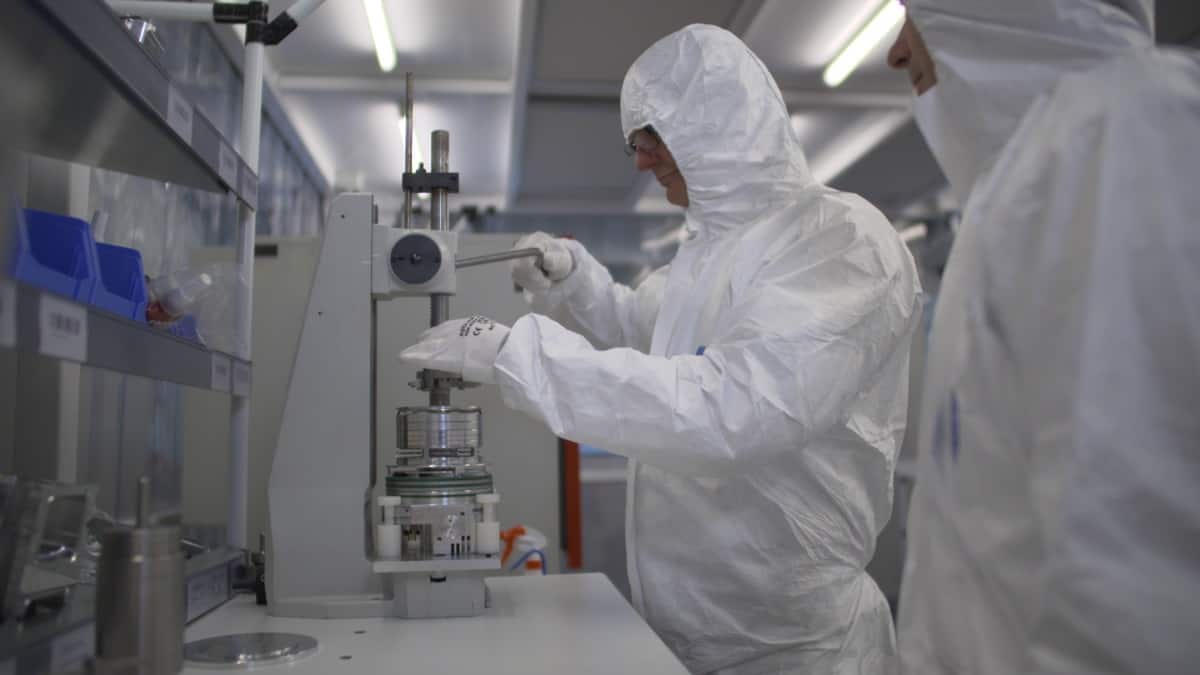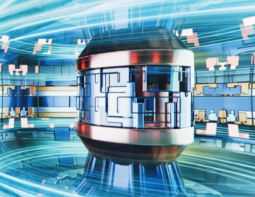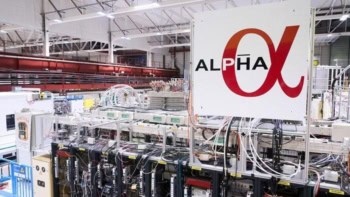
Mechanical turbomolecular pumps are nothing if not versatile. They’re a workhorse technology for analytical instrumentation OEMs – providing a core building block in mass spectrometry, electron microscopy, thin-film deposition systems and plenty more besides. They also enable diverse applications in frontline research – whether that’s in a “big science” particle physics facility or a university materials laboratory focused on nanoscale surface science and engineering. Either way, vacuum specialist Edwards reckons its nEXT family of mechanical turbomolecular pumps can only benefit from the vendor’s twin focus on these distinct – and very different – customer bases.
Over the past three decades, Edwards has shipped more than 320,000 turbomolecular pumps and pumping stations into a wide range of applications and markets – with significant sales growth over the past 10 years in particular. “We’re not only at the forefront of primary vacuum-pump technology, but we are also a technology and innovation leader in turbomolecular pumping,” claims Daniel Reinhard, manager, divisional product management, at Edwards.
“We have always addressed a good balance between the OEM instrumentation and scientific end-user markets,” he adds. “Because our pumps are used extensively by the analytical instrument OEMs, we get plenty of transferable advantages for the scientific end-user – including economies of scale, compact footprint, robustness and reliability.”

Those scientific customers are very much front-and-centre for Reinhard, who highlights field serviceability of the nEXT pumps as a significant win in terms of research productivity. Specifically, the nEXT design is such that the customer can change the lower bearing in the pump themselves using a simple toolkit (plus instructions on a YouTube video). “It’s a straightforward process and takes around 10 minutes to change the oil reservoir and bearing,” claims Reinhard. “This ‘design for serviceability’ translates into a lower cost of ownership – because there’s no need to send the pump back to a service hub when the bearing needs replacing – and also minimizes experimental downtime for our research customers.”
Another notable innovation within the nEXT range is the integration of an infrared sensor into the pump to measure the temperature of the rotor directly, whereas previously this measurement was based on a best estimate. “How far you can push your pump comes down to that rotor and how hot it’s getting,” explains Reinhard. “In the past, pump operation had to be fairly conservative, reducing pump speed to avoid overheating and potential damage to the rotor. Now, because we no longer have to estimate shaft temperature, users can push the pump harder – which means a bigger performance envelope, while providing peace of mind when it comes to robustness and reliability.”
Listening to the customer
As for the bigger picture, product development of Edwards’ turbomolecular pumps and pumping stations is shared between the company’s Global Technology Centre (GTC) in Burgess Hill, UK, and three specialist product companies located in Lutin, Czech Republic; Cologne, Germany; and Yachiyo, Japan. Within a diversified and global R&D effort, the GTC employs a team of scientists and engineers dedicated to core technology development and validation across all of Edwards’ product lines, including nEXT pumps. Effectively the GTC is the engine-room of new product innovation at Edwards, with the focus squarely on next-generation enabling technologies and product platforms.
While part of the GTC’s remit is to address requirements coming in from the end-users, the centre spends at least half of its time working on longer-range blue-sky R&D. “Some of this will be driven by direct market needs and really listening to customer requirements,” says Reinhard, “while some of it will be driven by the GTC team thinking there’s a new technology opportunity.”
The Edwards product companies, meanwhile, concentrate on development and evolution of existing product lines. A typical example of their role is the recent addition of an onboard micro USB port to the nEXT pumps, allowing users to configure, control and monitor the pumps remotely from a personal computer.
“We have really strong links from the sales teams into the core business,” says Reinhard. “That market intelligence helps us to understand what the customers want and what they don’t want, allowing market sector managers and product managers to define the priorities for continuous improvement of our nEXT pumps for the product companies. Next year, for example, we will be launching more nEXT variants to extend the pumping speed ranges covered by this platform.”
Another significant player in the Edwards innovation ecosystem is its product company in Eastbourne, UK, which specializes in the design, development and manufacture of electronics for use across the Edwards product range. All the electronics in the nEXT pumps, for example, are designed and manufactured in-house at Eastbourne – including the TIC and TAG controllers that support the pumps, as well as the controller in the T-Station pump carts. Engineering staff from Eastbourne are also part of the development and introduction teams for the nEXT pumps, “ensuring an incredibly close bond between pump and electronics that’s only possible with a full in-house electronics design and manufacturing capability”, says Reinhard.

“This means that nEXT pumps are optimized for this pairing, and we have full control and flexibility on our electronics,” he adds. “We can do variants for our analytical instrument customers very easily, something that is much harder if you purchase your electronics from a third party. Because we specialize in the electronics, we also can bring reliability and functionality benefits to our customers much faster and more easily than if the electronics were outsourced.”
Vacuum made easy
For many research scientists, of course, vacuum technology will always remain a means to an end – an essential enabler that works best when it does its job unnoticed and uninterrupted. A case in point is Felix Hofmann, whose group at the University of Oxford, UK, uses a range of experimental and analytical techniques to study the role that atomic-scale defects play in the mechanical, physical and failure properties of structural alloys.
“It’s usual to think of defects as something detrimental, something bad,” says Hofmann. “We’re interested in what sorts of defects are created under different conditions – whether mechanical deformation, chemical changes or irradiation – and also how we can control and tune those defects to deliver improved material functionality.”
For his part, Hofmann is typical of many scientific end-users of vacuum products. “What I want to do is think about vacuum as little as possible,” he explains. “Essentially I want a system that pulls the vacuum and is 100% reliable, 100% of the time – it’s that simple. We’ve got two of Edwards’ turbomolecular pumping stations in our lab for that reason.”
So what role does vacuum play in Hofmann’s science? One particular area of interest is thermal transport in very thin surface layers – and specifically the use of ion implantation to mimic the kinds of degradation that materials will undergo in future fusion reactors. The damaged layer thickness that this technique creates is only a few microns thick, which means that special laser techniques are needed to measure the material properties – in particular, thermal conductivity – within the very thin surface layer.
What’s more, those laser measurements need to be carried out in vacuum to avoid spurious signals from air next to the sample surface. “We’ve built a bespoke vacuum chamber that also gives us flexibility when it comes to inserting different types of sample environments,” says Hofmann. “For example, we’re currently in the process of building a heating stage; there will also be a deformation rig with the ability to do some electrical loading.”
Hardware aside, Hofmann says a key benefit of the relationship with Edwards is the active dialogue after the point of sale. “What’s been really important is having, in some sense, real flexibility in terms of the vacuum chamber configuration,” he explains. “It turns out the original vacuum system design we came up with was not optimal. But working together with Gavin [our sales engineer at Edwards] helped us to realize that we can separate the turbomolecular pump from the pumping station and attach it directly to the chamber, while still getting the push-button functionality that the pumping station offers.”
- Edwards will feature the nEXT range of mechanical turbomolecular pumps on booth W10 at the Vacuum Expo in Coventry, UK (9-10 October 2019).
Pump it up: products in brief
The Edwards’ family of mechanical turbomolecular pumps and pumping stations comprises the following core product lines:
- nEXT turbomolecular pumps are hybrid bearing pumps with a compound drag stage and integrated controllers for pumping speeds from 47 to 400 l/s. All nEXT pumps feature a permanent magnetic upper bearing, which eliminates hydrocarbons at the top of the rotor, and an oil-lubricated lower bearing for reliable high-speed operation. The on-board controller interfaces directly with Edwards’ TIC and TAG controllers to facilitate system integration.
- The T-Station 85 is a compact turbomolecular pumping station combines an nEXT85H turbomolecular pump with either a dry-diaphragm or oil-sealed backing pump and a simple controller. Pumping speeds range from 47 to 84 l/s. The T-Station 85 comes with an integrated turbo and active gauge controller to enable single-button start/stop of the system and control of one active gauge in general laboratory applications.
- nEXT turbomolecular pumping stations are configurable with turbomolecular pump speeds ranging from 47 to 400 l/s and a choice of oil-sealed or dry backing pumps ranging from 1 to 20 m3/h. All nEXT pumping stations feature an integrated TIC turbo and instrument controller, offering full system control (including up to three active gauges) via an intuitive user interface. The pumping stations are supplied ready to run straight out of the box and include RS232 serial communications and Windows software for monitoring and control.




